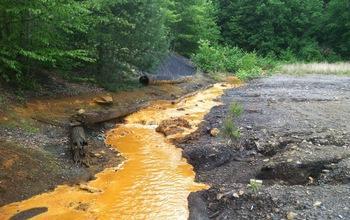New geochemical tracers can identify any hydraulic fracturing flowback fluids that could have spilled into the environment, according to field tests at a spill site in West Virginia and downstream from an oil and gas brine wastewater treatment plant in Pennsylvania.
Using boron and lithium tracers, scientists can determine if fracking fluid contamination has been released into the environment, which will help identify ways to improve disposal and treatment of shale gas wastewater.
Hydraulic fracturing fluids typically contain mixes of water, proprietary chemicals and sand. Mixtures can vary from site to site. Drillers inject the fluids down gas wells at high pressure to crack open shale formations deep underground and allow natural gas trapped within the shale to flow out and be extracted.

Nothing to do with fracking, but this is acid mine drainage into a stream in western Pennsylvania. Credit: Nathaniel Warner
After the shale has been fractured, the fracturing fluids flow back up the well to the surface along with the gas and highly saline brines from the shale formation. The process is contained but some people fear that toxic fracturing fluid chemicals in this flowback could contaminate nearby water supplies if they're accidentally spilled or insufficiently treated before being disposed of.
"By characterizing the isotopic and geochemical fingerprints of enriched boron and lithium in flowback water from hydraulic fracturing, we can now track the presence of 'frac' fluids in the environment and distinguish them from wastewater coming from other sources, including conventional oil and gas wells," said Duke University geochemist Avner Vengosh, who co-led the research. "This gives us new forensic tools to detect if frac fluids are escaping into our water supply and what risks, if any, they might pose."
Deep-well injection is the preferable disposal method, but environmentalists believe that injecting large volumes of wastewater into deep wells can cause earthquakes. In Pennsylvania, much of the flowback is now recycled and reused, but some is discharged into local streams or rivers after being treated.
The authors say it's possible to identify the presence of fracturing fluid in spilled or discharged flowback by tracing synthetic organic compounds that are added to the fluid before it's injected down a well, but the proprietary nature of these chemicals, combined with their instability in the environment, limits the usefulness of such tracers.
By contrast, the new boron and lithium tracers remain stable in the environment.
"The difference is that we are using tracers based on elements that occur naturally in shale formations," Vengosh said.
When drillers inject fracturing fluids into a shale formation, they not only release hydrocarbon, but also boron and lithium that are attached to clay minerals in the formation. As the fluids react and mix at depth, they become enriched in boron and lithium.
As they're brought back to the surface, they have distinctive fingerprints that are different from other types of wastewater, including wastewater from a conventional gas or oil well, and from naturally occurring background water.
"This type of forensic research allows us to clearly identify possible sources of wastewater contamination," Vengosh said.
Source: National Science Foundation





Comments